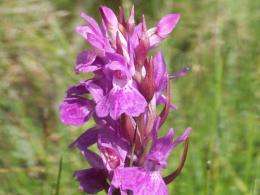Speeding up evolution: Orchid epigenetics

Organisms adapt to their dynamic environment using various strategies. Ovidiu Paun, working at the Department of Systematic and Evolutionary Botany, investigates how marsh orchids adjust to and diffuse in different habitats. Initial results have suggested that the future isn't as bleak as one would have expected: Variation in epigenetic information, recently detected as heritable signals outside the DNA, enables plants to adapt quickly to environmental changes.
Epigenetics is the study of heritable signals not encoded in the DNA sequence: "That widely extends what we have assumed until now, namely that outside the DNA there is no heritable information. Very recently we started to learn that there are other important heritable mechanisms within the cell that have an influence on a plant's development and traits", project leader Ovidiu Paun explains. Epigenetic signals can basically modify gene expression patterns and they are part of the response mechanisms of an individual to its environment. It's understood that those signals have a significant impact on the process of translating genetic information into the phenotype, hence on the characteristics of an organism.
Epigenetics and environmental issues
"Those signals are able to change fast and on a wider scale, whereas genetic information takes much longer to mutate. This is why epigenetic investigations connect well to environmental issues like climate change", the scholar continues. One of those epigenetic mechanisms is the methylation of DNA, a simple chemical modification which results in reduced activity or even silencing (inactivation) of a certain gene. "This regulatory mechanism has been compared to the interpretation of a piece of music: You have the same score, but one musician plays it differently to the other", Paun says.
In a nutshell: The evolution of flowering plants
At several times during plant evolution a whole genome duplication occurred, meaning that a cell's nucleus subsequently possesses double the number of genes. Hence the resulting genomes contain so called redundant genes – copies that carry out a similar function. Over evolutionary time the redundant copies diverge and are able to acquire new functions – this is one key way for plants to evolve and become more and more complex. All flowering plants have had such duplication events in their history. The more recent polyploid organisms don't inherit just one chromosome set from their mother and one from their father, but two or even more chromosome sets from each parent. As epigenetic signals are able to switch different copies of genes on and off, they have a wider "playground" in polyploid plants.
The adaptability of orchids
One of the first documented examples of epigenetic variation in natural populations was found in the three orchids the botanist is studying - Dactylorhiza majalis, D. traunsteineri and D. ebudensis. The plants are natural hybrids of the same parental species pair and they all have twice as many chromosomes as their parents. Even though all three of them have the same genetic heritage, they are different in morphology and show different ecological adaptations. Taking into account the results of his previous research, Paun is going to analyse the genes that are expressed in those plants using the latest methods, capable of investigating at once all genes that a cell is expressing at a moment in time. He aims to find out if the main differences between the three orchids are indeed quantitative – in one orchid a gene might only be expressed once, in the other the same gene may be expressed, but a hundred times. The variation found will be linked to the adaptation to different environments.
Of different morphology
Paun's earlier results have indicated that these orchids' phenotypic variation is due to epigenetic change – namely the silencing and activation of different gene combinations in different species – influenced by their specific environment. "Their difference in morphology is quite remarkable. Dactylorhiza ebudensis, for example, is endemic on an island in Scotland. It forms just a single population with plants no taller than 10 centimeters that have just a couple of flowers per inflorescence. D. majalis is distributed in the Pyrenees, the Alps and in Scandinavia and can grow up to 90 centimeters with around forty flowers in its inflorescence. The third one, D. traunsteineri, is found in Scandinavia and Britain as well as the Alps and is morphologically somehow in between the other two", Paun explains.
All three orchids inhabit marsh-like habitats, but they prefer for example different soil moisture and soil pH. Paun's studies have shown that the combination of temperature and the amount of water available is also crucial for the divergence of these orchids in different habitats.
Out in the Alps
Apart from the molecular investigations, the project also includes an experimental part carried out in the Botanical Garden of the University as well as in the Alps. The scientist explains: "Late spring is for me the best time of the year because I get to go out in the field and learn more about these amazing plants."
Provided by University of Wien














